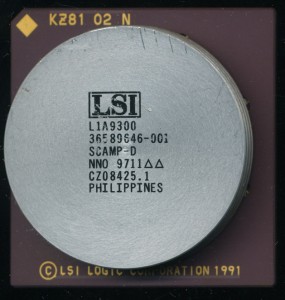The Forgotten Ones: Unisys SCAMP-D Mainframe
Burroughs Corporation started in 1886, making it the oldest computation company still in existence. In September 1986, Burroughs merged with Sperry Corporation (of UNIVAC fame) to form Unisys which exists to this day. The story of the SCAMP though begins in 1961, with the introduction of the Burroughs B5000 mainframe. Burroughs was a bit late to the mainframe market, but entered it with a computer that was rather ahead of its time. The B5000 was a stack based design, and designed from the get go with the programmer in mind, it was designed with software implementation (namely the high level languages ALGOL and COBOL) in mind, rather then wrapping software around hardware design. This made it easy to program, and thus allowed Burroughs to take customer from IBM, who released the System/360 shortly thereafter.
In 1969 the B6500 was released, improving on the design and with it the MCP (Master Control Program). MCP was Burroughs operating system, and what came to define their machines for the decades to come. The B6000 line (like the B5000) was a 48-bit architecture. In addition to the 48-bit data size was a 3-bit tag that told the system what that data was, code, data, type, etc. This simplified the instruction set greatly as instruction need not be specific to each data type, they could check the tag and know what type of data. Coincidentally this also allowed for greater security as well, many of the buffer overflow exploits we have seen in the modern day were not possible on a Burroughs, the tag did not allow data to be executed as code, essentially it could perform as a NX flag (No Execute) such as is on modern x86 processors.
In 1984 the first A-series was released, as well as what would become ‘e-code’ a definition of the Burroughs instruction set that could be implemented in a variety of processors. Like the DEC VAX, Burroughs wanted to clearly define the instruction set, and leave the implementation of it up to the hardware designers. This helped ensure robust compatibility, and future proofing, ad is why MCP programs from the 70’s still can be ran today.
In 1989 Unisys released the first single chip (actually a MCM) version of the A-series and called it the SCAMP (Single Chip A-series Mainframe Processor). Several other versions were made into the 1990’s and the release of the ClearPath series. ClearPath, as the name suggests, was Unisys attempt to make an easier transition from the A-Series and E-mode MCP to Linux/Windows NT running on x86. They wanted to provide their customers with the option to run new code, on new hardware, while still preserving the software from before. It was a successful program, in no small part due to the design of the architecture. Low end systems ran on Pentium or Pentium Pro Processors and emulated MCP in software. Slow, but effective. Mid and High end systems ran actual hardware to implement the MCP, though not always directly.
The Unisys ClearPath A2400 was released in 1997 as a mid-range A-series system, and with it, a new processor, the SCAMP-D. The ‘D’ refers to the fact that it is designed to run the Delta revision of the MCP E-code. The SCAMP-D was manufactured by LSI on a 0.6 micron CMOS process and contained 1.2 million transistors. It ran at 32 MHz and contained a 1K (1k x 90 bits) General cache as well as a 2K (2k x 90 bits) microcode cache. a 384K external L2 Cache was also supported as well as up to 1.5GB of memory. By now you are wondering why the word length was 90 bits rather than 48. Like modern x86 processors, the SCAMP-D is microcoded, it does not directly execute e-code, rather each e-code instruction generates one or more microcoded 90-bit instructions on the SCAMP. This control store is actually programmable, so the SCAMP-D could be programmed to execute some other high level language as well.
Later versions of the ClearPath Libra and Dorado processors were made by IBM for Unisys and continued to support E-mode instructions in hardware. The last of the hardware E-mode processors, the Dorado, is to be discontinued this year, though the Libra line continues full support of it in software, and likely will for many years to come.



May 2nd, 2017 at 5:24 pm
Many years ago I worked with a Burrows enhanced “D”. I was told it was burrows first attempt at risk programming. It was serial number 1. Remember wire wrapping an interface board for it to interface with a cassette data tape drive. Still had magnetic core memory, card reader and tape drives, along with disk pacs.
Programming language was symon sycol. Don’t remember correct spelling.
Can’t seem to find any history on this series.